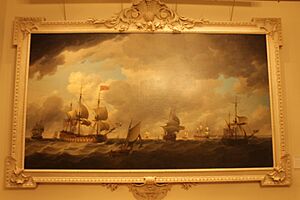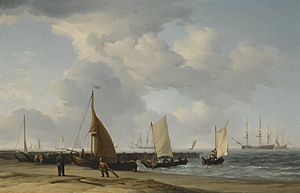Charles Brooking facts for kids
Charles Brooking (born around 1723, died 1759) was a talented English artist. He was famous for painting amazing pictures of the sea, ships, and naval battles.
Contents
Who Was Charles Brooking?
Early Life and Family Connections
It's very likely that Charles Brooking's father was also named Charles Brooking. His father worked as a painter and decorator at Greenwich Hospital (London) from 1729 to 1736. The elder Charles Brooking had also worked in Plymouth and Ireland.
In 1732, young Charles Brooking became an apprentice. This meant he was learning a trade, probably painting, from his father.
Becoming a Known Artist
A story about Brooking says he worked for an art dealer in Leicester Square, London. This dealer didn't treat him very well. But then, a kind man named Taylor White, who was in charge of the Foundling Hospital in London, discovered Brooking's amazing talent.
Brooking became much more famous in 1754. The Foundling Hospital asked him to paint a huge picture called A Flagship Before the Wind Under Easy Sail. After he finished it, he was even made a special helper and guardian of the hospital. This painting was meant to be a companion to another large sea painting by Peter Monamy.
His Students and Later Years
Some people believe that the famous marine artist Dominic Serres learned from Brooking for a short time. It was also thought that Francis Swaine might have been his student, but they were almost the same age, so this is less likely.
Charles Brooking sadly passed away on March 25, 1759.
What Kind of Art Did Brooking Make?
His Earliest Known Paintings
Brooking's first known artworks are two paintings from 1740. One shows a harbor at night under the moon, and the other shows a ship on fire. He signed these paintings and wrote his age, 17, on them.
By 1752, he was already called a "celebrated painter of sea-pieces." This means he had been painting for at least 12 years before that time. He even worked for a naturalist named John Ellis, helping him draw plants.
Capturing History and Sea Life
Some of Brooking's paintings show real historical events. For example, he painted a battle between Commodore Walker and French ships from May 23, 1745. This painting is now in the Greenwich Maritime Museum.
Most of his early works are harder to put an exact date on. However, you can see how his style developed over time. At first, his paintings showed some influence from Peter Monamy, another marine artist. But soon, Brooking developed his own unique style. He moved away from the usual way of painting formal ship portraits, though he did paint some of those too.
Accuracy and Detail in His Work
Brooking was known for his incredible accuracy and careful attention to detail. He knew a lot about ships and how they worked, as well as the sea itself. He could paint waves and wind in a very realistic way. People at the time said he had spent "much at sea" and he even owned a small yacht. It seems he worked on boats when he was younger, perhaps on a pilot boat.
Later in his career, some of his paintings showed the influence of Willem van de Velde the Younger, another famous marine painter.
Where to See His Art Today
The National Maritime Museum in Greenwich, London, has a large collection of Brooking's art. They have 23 of his oil paintings, a full set of 28 engravings made from his works, and 4 drawings. These drawings were given to the museum by former U.S. President J.F. Kennedy.
In 2008, a special plaque honoring Charles Brooking was put up in London.



